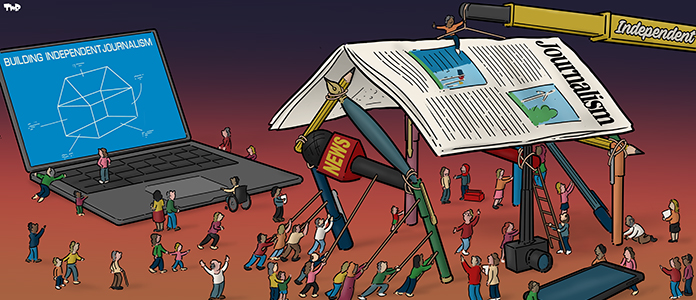The economic crisis, which has forced thousands of practices to close, has had an unprecedented impact on the world of architecture. Until recently, architecture students could still dream of following in the footsteps of such idols as Rem Koolhaas and Ben van Berkel who traveled to the four corners of the world to create acclaimed wow-factor buildings. Today they know they will be lucky if they succeed in finding a job. The director of the Netherlands Architecture Institute (NAi), Ole Bouman, believes that architecture contributed to the current global crisis by producing "buildings that paid no heed to issues of accessibility, social cost-benefit, energy consumption and future management" — a position that he espouses in his latest book Architecture of Consequence, published by NAi Uitgevers, which also serves as a catalogue to an eponymous exhibition currently organized by the NAi. This is just one aspect of a more general position that leads Buman to insist that, with hindsight, architecture is clearly implicated in an accumulation of modern ills that includes traffic jams, overburdened airports, vast cowsheds and pigsties, lawless urban areas and ghost towns. In illustration of this argument, he identifies a shift in perspective which now sees evidence of impending crisis in phenomena that were until recently perceived to be a reflection of the unprecedented success of globalization.
Alternatives to wow-factor architecture
Notwithstanding his contention that architecture helped launch the current global crisis, Bouman, also insists that architects will play a key role in devising solutions to the current malaise. But for this to happen, the profession will have to embrace significant change. For a start, architects will have to give up the long-running quarrel over the relative merits of modern and traditional architecture that has raged for more than a century. Secondly, instead of inventing "the ingenious concepts" which mainly appeal to architects, they will have to turn their attention to the real needs of society. To this end the exhibition organized by the NAi presents 25 cutting-edge Dutch architectural practices, whose designs underline the notion that architecture can play a wider social role that takes greater account of problems in broad range of fields including food production, health, energy, planning and transport, social organization and the current economic system.
Most of the practices selected by Bouman aim to promote alternatives to an "architecture of spectacle" or wow-factor architecture characterized by imposing facades. The common denominator is a focus on the quest for solutions to social problems. In the case of the Atelier Kempe Thill, this involves a break with the stereotypical notion of boring and uninspired social housing. Another practice,2by4-architects, specializes in the construction of low cost housing over industrial hangars, which uses design to address issues of depopulation, a lack of financial resources and stable employment.
Channelling waste energy to heat swimming pools
At the same time, reference to the high ideal of sustainability does not necessarily imply an architecture that is wholly devoid of any playful aspects. The NAi exhibition offers many examples of promising Dutch design that has succeeded in remaining inventive, in spite of difficulties imposed by the current economic crisis. What is most remarkable is a willingness to take on problems that were hitherto considered to be outside the ambit of architecture. The result is a range of plans for carbon neutral buildings, buildings that produce energy, high quality dwellings for low-income users, a villa composed of waste products, and the ambitious Park Supermarkt project, which aims to adapt local polders for food production and leisure activities.
Another visionary project proposes to build underground hotels, which will channel waste energy to heat open air swimming pools, beneath specially created sand dunes near IJmuiden. If the vision expressed by the persuasive force of these projects is anything to go by, Dutch architecture will continue to play a vital role in the society of the future. Or at least, it demonstrates that we will still need architects to help resolve the problems created by their colleagues in previous generations.
Netherlands
How sweet is my suburb
Travellers fortunate enough to wander into the boroughs surrounding the cities of Amsterdam, Rotterdam and Utrecht will be amazed at what they find, *reports*Welt am Sonntag: the new Dutch architecture is marked by "a highly imaginative, lively and inventive approach" to a style of dwelling much feared by German aesthetes: the humble semi-detached home. According to the Sunday weekly, the Dutch have succeeded in transforming this symbol of lower-middle class ennui to create "tiny farms right in town centres." Backing onto apartment buildings "styled on baroque castles" and housing projects "inspired by early twentieth-century resort towns," architects like Rob Krier and Christoph Kohl have created atmospheric clusters of houses on intersecting planes complete with secluded courtyards and rooftop terraces. State funding has played a major role in the success of the "Dutch planning model," which promoted the construction of new housing to absorb a demographic boom. Having provided approximately 95% of new building for close to a century, the state reduced its role to produce 30% of new homes in 1994. The liberalization of the Dutch housing market has been accompanied by support for quality design and innovation in architecture: "Even in the midst of the crisis in 2009, the state provided 4.5 millions euros of funding for the promotion of young architects."
Do you like our work?
Help multilingual European journalism to thrive, without ads or paywalls. Your one-off or regular support will keep our newsroom independent. Thank you!












